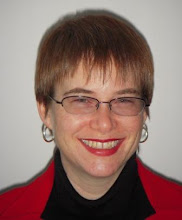I attended TechSoup’s NetSquared Conference today in Second Life about the launch of the Nonprofit Commons 2. If that sentence doesn’t make any sense to you, don’t worry. I’ll explain. Up until now, I have been avoiding Second Life - an online virtual world where you can meet people, shop, fly, do lots of fun stuff. It took me years to get over my computer game addiction and I don’t need another distraction from my job search. But now I find that nonprofits are using Second Life to spread their message, fundraise, and even fulfill their missions “in world.” I had to check that out.
It was a “mixed reality” event, meaning that the live conference was occurring in
There were some technical difficulties getting the sound to work so we missed the first half of the panel. I was having plenty of technical difficulties of my own. I just joined Second Life this morning and had a lot to learn. Once you create your avatar, you are taken to “
Here’s what I learned from the three speakers I heard:
First was Jani Myriam, founder of the Transgender Resource Center (TRC). She talked about how Second Life (SL) was a safe, anonymous place for her to explore gender issues in a way that was not safe in the “real world” and eventually lead her to make substantial real world changes in her life. Jani saw a need and a solution so she created the
The next speaker was Jessica Dally from Community Voicemail (CVM) – very much a real life organization that provides voicemail services to people in crisis. CVM was introduced to the possibilities in Second Life through their major technology partner, Cisco Systems. Apparently, Cisco has a large presence in SL. Jessica mentioned it was helpful that she had some personal experience with SL because it’s not easy to jump into. (I was thinking “yeah, you can say that again.”) She said the biggest advantage was making connections with other nonprofits. They can’t have an office in every city, so they rely on partnerships with other nonprofits on a local level. She also mentioned the opportunity to meet people you wouldn’t otherwise (like the CTO of voice solutions for Cisco). This model was very interesting to me. I figured that people who don’t have access to voicemail also don’t have access to Second Life. But CVM isn’t using SL to connect with those they serve. This was a great way to make and strengthen partnerships.
The last speaker was Rik Riel from Global Kids. This is a 20-year-old nonprofit for teens in
Lastly, Rik answered a question that had been buzzing in my head – what about the kids who don’t have internet access. Global Kids is working on a project called “Switchboard” that allows users to exchange SMS text messages with people in the virtual world. The first test case they are planning involves teens in a refugee camp in
Rik’s slides are available at Slideshare. I looked at them so I could see what I was missing since I couldn’t get the presentation to work. Like all good Powerpoints (there are so few of them) the slides weren’t much use without the presenter. However, coincidentally (or not) I found on the Nonprofit Commons wiki a white paper titled “Best Practices for Non-profits in Second Life” from Global Kids which looks pretty good. I intend to read it soon.
Lastly, I got a magic carpet ride tour of the Nonprofit Commons. It is home to dozens of organizations from all over the world – too many to list here. Some, like Giving Circles, I had never hear of and others, SPCA are well known. It’s not just about information exchange, our tour guide mentioned that Kiva, which provides micro-loans, has a tip jar in their office that raises real money. The



